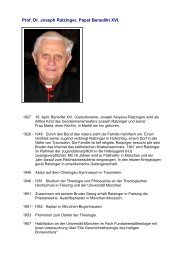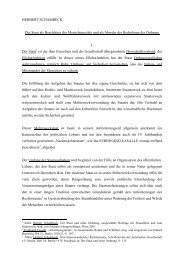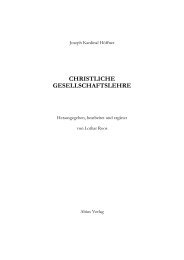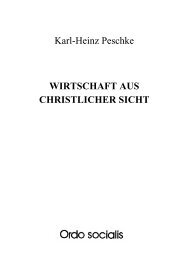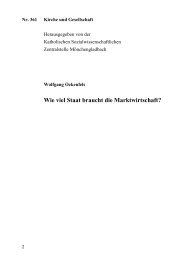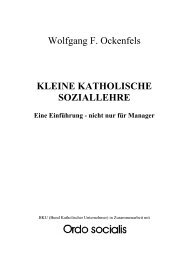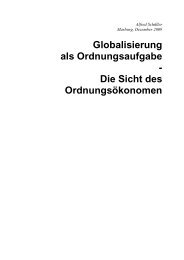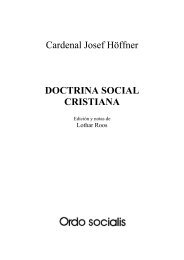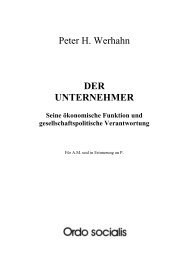Joseph Cardinal Höffner CHRISTIAN SOCIAL ... - Ordo Socialis
Joseph Cardinal Höffner CHRISTIAN SOCIAL ... - Ordo Socialis
Joseph Cardinal Höffner CHRISTIAN SOCIAL ... - Ordo Socialis
Create successful ePaper yourself
Turn your PDF publications into a flip-book with our unique Google optimized e-Paper software.
a) Church and state go back „to the same origin, namely, God“ (Pius XII, October 29, l947).<br />
In consequence of the Christocentrism of all creation, all natural-law orders are also related to<br />
Christ.<br />
b) Church and state occupy themselves „with the same man, with his personal, natural or supernatural,<br />
dignity“ (Pius XII, October 29, l947). In many questions such as the sequence of<br />
holy days, marriage law, and the school system, the field of duties of Church and state touch<br />
upon one another („mixed concerns“). „Inasmuch as each of these two powers has authority<br />
over the same subjects--related differently, but still remaining one and the same thing...the<br />
course of each“ must be „in right correlation with the other“ (Immortale Dei).<br />
c) The form of relatedness between Church and state that results from the commission of the<br />
Church to be the guardian and preacher of the moral order is particularly full of tension. On<br />
November 9, l903, Pius X declared that he foresaw „that some will take offence when we<br />
declare“ that we are obligated to protect „the principles of order, authority, justice, and fairness,“<br />
and to do so „in private and public life,“ and also „in the social and political realms.“<br />
Along the same lines, Pius XII says: „It belongs to the indisputable jurisdiction of the Church<br />
to determine in those concerns of social life which approach or already touch the realm of<br />
morality whether the foundations of the current social order agree with the eternally valid<br />
order that God, the creator and redeemer, has made manifest through natural law and revelation“<br />
(June l, l94l).<br />
2. Historically, the relation between Church and State has assumed very different forms:<br />
a) In the system of Church states, such as the ecclesiastical principalities before the French<br />
Revolution and the Papal States, the same person was the holder of spiritual and secular<br />
power. Considerable objections are to be raised against this combination which stems from<br />
German thought, since this system leads to a blurring of the boundaries between the two<br />
realms, and since difficulties and errors in the management of the state threaten to undermine<br />
confidence in the pope and bishops.<br />
b) The system of theocracy (hierocracy) is untenable, since the autonomy of the state is here<br />
mistaken or denied.<br />
c) The state-church system (e.g., Gallicanism, <strong>Joseph</strong>inism) is incompatible with the essence<br />
of the Church, since it violates the autonomy of the Church.<br />
d) The anticlerical separation of Church and state, which often appears in the form of Church<br />
persecution (the pagan Roman Empire, the Bolshevist states), as well as the ‘neutral separation’,<br />
in which Church and state live alongside each other in an almost unrelated fashion<br />
(USA), mistakes the fact that Church and state are essentially related to each other. In an ideologically<br />
pluralistic society, however, the ‘neutral separation’ can be appropriate under certain<br />
circumstances.<br />
e) In countries in which Church and state have been closely intertwined for centuries, a partial<br />
or ‘lame’ separation (U. Stutz) has developed, which does indeed recognize the independence<br />
and autonomy of Church and state, but institutionally connects both realms through, for example,<br />
the recognition of the Church as an official, legal corporation, through the recognition<br />
of the Church’s right to levy taxes, through the establishment of denominational schools,<br />
theological faculties, and so on. This system has been realized in the Federal Republic of<br />
Germany, even if many would like to describe this as a ‘free Church in a free state’ rather<br />
than of a ‘lame’ separation. Incidentally, in a certain sense, the public commission of the<br />
155




